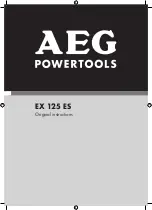
11
RS 100 Q
Sanding dust is extracted through the extraction
channels in the sanding pad directly to the mate-
rial removal point.
a)
Inboard extraction
The machines are fitted with inboard extraction as
standard. The turbo-filter (1.6) has to be changed
when it is so full of dust that the extraction power
diminishes.
Inserting a turbo-filter
- Insert rear cardboard section with slot (1.5) onto
the retaining strip of the filter holder
- Insert the front cardboard section with seal-
ing lip onto the extraction adapter on the filter
holder (1.7),
- Push the filter holder with its opening (1.3) as
far as it will go onto the extraction nozzle (1.9)
of the machine and clamp tight by turning rotary
knob (1.9).
To prevent dust from escaping from the turbo filter
during transport, seal off the extraction opening
by turning the flap (1.4).
b)
External extraction by an extraction unit
In order to avoid frequent changing of the turbo-
filter when carrying longer sanding jobs, it is
possible to connect a Festool extractor to the unit
instead of using inboard extraction. In this case,
the extraction pipe (Ø 27 mm) of the extraction
unit is connected to the suction nozzle (1.3).
4.2
Sanding pad
The standard Stickfix sanding pad for Stickfix
abrasives can be replaced with a sanding pad for
clamping abrasives. Unscrew the six screws (2.1)
to do this.
Both sanding pads (with and without Stickfix coat-
ing) are also available with a side edge protector
to prevent the sanding base from degrading pre-
maturely when sanding corners.
The accessory and tool order number can be found
in the Festool catalogue or on the Internet under
“www.festool.com”.
4.3
Attaching sanding material
Always use original Festool sanding ma-
terials!
Stickfix abrasives
The appropriate Stickfix sanding paper
and Stickfix sanding felt can be fastened
quickly and easily onto the Stickfix sand-
ing pad.
The self-adhesive sanding material is simply
pressed onto the sanding base and held safely in
place by the Stickfix sanding base velcro surface.
After use, the StickFix sandpaper is simply pulled
off.
Abrasives to clamp
Festool offers perforated abrasives to
clamp.
Unperforated abrasives can be perforated with
the “Lochfix“ (accessory).
- Replace the Stickfix sanding pad with a sanding
pad for abrasives for clamping,
- Secure an abrasive sheet in place using the two
clamping devices (1.10, 3.2). Press the levers to
release the clamping devices.
Once clamped in position, make sure the
abrasive paper is taut and sits flat on the
sanding pad.
4.4
Auxiliary handle
The auxiliary handle (3.1) can be set to different
positions. To do this, pull the handle forwards,
turn it to the desired position and release it again.
5
lnstructions on application
Never overload the tool by using too much pres-
sure! The best sanding results are achieved when
applying moderate pressure. The sanding perfor-
mance and quality depend mainly on the choice
of the right sanding material.
Metalworking
The following precautions are to be taken
when processing metals for safety rea-
sons:
- Pre-connect a residual current circuit-breaker
(FI, PRCD).
- Connect the machine to a suitable dust extractor.
- Clean tool regularly of dust accumulations in
the motor housing.
Wear protective goggles.
6 Accessories
The accessory and tool order number can be found
in your Festool catalogue or on the Internet under
“www.festool.com”.
Содержание RS 100 Q
Страница 2: ...2 1 3 2 3 3 1 1 3 1 1 2 1 3 1 4 1 5 1 8 1 10 1 9 1 7 1 6 1 3 2...
Страница 3: ...4...
Страница 5: ...5 RS 100 Q b c d e f g h 4 a b c d e f g h 5 a b c d e f 130 C...






























